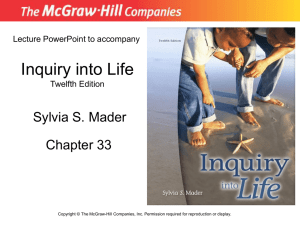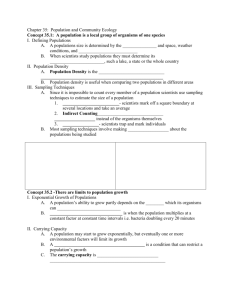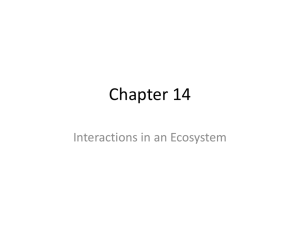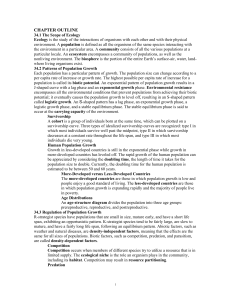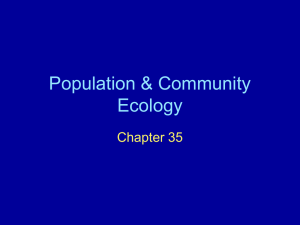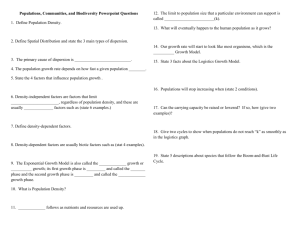Chapter 33: Population Growth and Regulation
advertisement
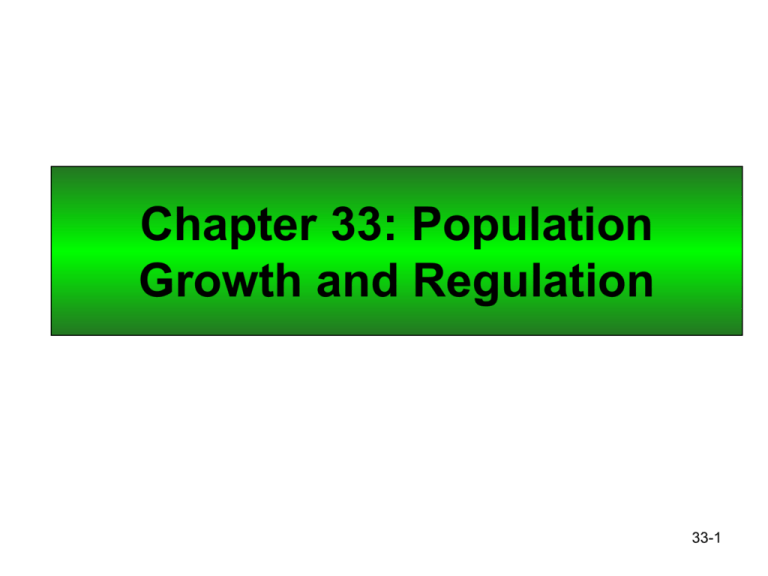
Chapter 33: Population Growth and Regulation 33-1 Scope of Ecology Ecology is the study of the interactions of organisms with other organisms and with the physical environment. The study of ecological interactions can be undertaken at many levels: the individual organism, populations, communities, ecosystems, and the biosphere. A population is all the members of the same species interacting with the environment at a particular locale. 33-2 A community consists of all the various populations in an area. An ecosystem is the community plus its nonliving habitat, including abiotic (nonliving) and biotic (living) components. The biosphere is the portion of the entire earth’s surface, including air, water, and land, where living things exist. Ecology describes the environment and tests models. 33-3 Ecological levels in a coral reef 33-4 Community Composition and Diversity The composition of a community is a listing of populations present. The diversity of a community adds in the relative abundance of individuals. Ecologists have ideas about why populations assemble together in the same place at the same time. 33-5 The interactive model of community structure views the community as a stable assemblage that remains the same over time. The individualistic model views a community as a collection of species where each responds to its own requirements and tolerance factors. 33-6 Two terrestrial communities 33-7 33-8 Community Stability and Diversity A change in community composition over time is called ecological succession. Primary succession starts on areas devoid of soil and secondary succession starts with pioneer species in areas where there is already soil such as an abandoned field. Succession also occurs in aquatic communities. 33-9 Secondary succession in a forest 33-10 Models of Succession The climax-pattern model predicts that a particular area will always lead to a climax community characteristic for that area (i.e., tropical rain forest at the equator). The facilitation model says that each proceeding stage facilitates the development of the next stage. The inhibition model says that each preceding stage tries to prevent the arrival of the next stage. 33-11 The tolerance model says that plants from various stages try to colonize at the same time and chance arrival of seeds determines the outcome. The length of time it takes trees to develop gives the impression of a series of plant communities from the simple to the complex. These models are not mutually exclusive, and succession is probably a complex process. 33-12 Population Characteristics and Growth Population density is simply the number of individuals per unit area or volume. Distribution of these individuals can be uniform, random, or clumped. Most members of a population are clumped, as are the members of a human population. 33-13 Patterns of distribution within a population 33-14 Abiotic factors such as water, temperature, and availability of organic nutrients often determine a population’s distribution. Biotic factors, such as the availability of food, or presence of disease, affect the distribution of populations. Limiting factors are those factors that determine whether an organisms lives in an area. 33-15 Patterns of Population Growth Each population has a particular pattern of growth. The per capita rate of increase is calculated by subtracting the number of deaths from the number of births and dividing by the number of individuals in the population. It is assumed that immigration and emigration are equal. 33-16 Every population has a biotic potential, the greatest possible per capita rate of increase under ideal circumstances. Two possible patterns of population growth are considered. Exponential growth results in a J-shaped curve because as the population increases in size so does the expected increase in new members. 33-17 Biotic potential 33-18 Exponential growth 33-19 Environmental resistance occurs when most environments restrict growth, and exponential growth cannot continue indefinitely. Under these circumstances logistic growth occurs and an S-shaped growth curve results with four phases: lag, exponential growth, deceleration, and stable equilibrium. When the population reaches carrying capacity, the population stops growing because environmental resistance opposes biotic potential. 33-20 Logistic growth 33-21 Survivorship Populations are made up of individuals of different ages. Populations tend to have one of three types of survivorship curves, depending on whether most individuals live out the normal life span (type I), die at a constant rate regardless of age (type II), or die early (type III). Much can be learned about the life history of a species through its survivorship curve. 33-22 Survivorship curves 33-23 Human Population Growth The human population is expanding exponentially. The doubling time is the length of time it takes for a population to double, currently estimated at 53 years. Only when birthrate equals death rate will there be zero population growth. 33-24 More-Developed Versus LessDeveloped Countries Most of the expected increase in human population will occur in certain lessdeveloped countries (LDCs) of Africa, Asia, and Latin America. Doubling time in more-developed countries (MDCs) is about 100 years because a decrease in death rate due to medical advances was followed by a decrease in birth rates. 33-25 Standard of living 33-26 World population growth 33-27 The relationship between decreased death rate followed by a slower birth rate is called demographic transition. Despite introduction of medical care, LDCs still have twice the MDC growth rate. Support for family planning, social progress, and delayed childbearing could help prevent an expected increase in population size. 33-28 Age Distributions Many MDCs have a stable age structure, but most LDCs have a youthful profile— a large proportion of the population is younger than age of 15. This means their populations will expand greatly in the near future. Zero population growth or replacement reproduction does not occur when each couple has only two children because there is momentum from younger women entering reproductive years. 33-29 Age-structure diagram for MDCs 33-30 Age-structure diagram for LDCs 33-31 Regulation of Population Growth Two life history patterns exist in populations. Opportunistic populations have a short lifespan, small stature, and produce many offspring to take advantage of new resources. Equilibrium species live longer, are larger, and produce fewer young but have greater parental care; they hold population size near carrying capacity. 33-32 Life history patterns 33-33 Population growth is limited by both density-independent factors (e.g., weather) and density-dependent factors (predation, competition, and resource availability). Density-independent factors operate regardless of population density. Density-dependent factors increase in intensity as population size increases. 33-34 Competition Competition occurs when two species try to use a resource that is in limited supply. According to the competitive exclusion principle, no two species can occupy the same ecological niche at the same time when resources are limiting. Resource partitioning occurs when resources are partitioned between two or more species. 33-35 Competition between two populations of Paramecium 33-36 Competition between two species of barnacles 33-37 Predation Predation occurs when one living organism, the predator, feeds on another, the prey. Predators include lions, whales that filter feed, parasites that draw blood from hosts, and herbivores that eat grass, trees, and shrubs. 33-38 Predator-Prey Population Dynamics Predator-prey interactions between two species are influenced by environmental factors. Cycling of population densities may occur, as in the case of the Canadian lynx and hare; predators kill off prey and then the predator population declines when food is in short supply. Predator-prey systems are not usually simple two-species systems. 33-39 Predator-prey interaction: lynx and snowshoe hare 33-40 Prey Defenses Coevolution occurs when two species adapt to selective pressures of each other. Prey defenses against predation take many forms: camouflage, use of fright, and warning coloration are three prey defense mechanisms. 33-41 Antipredator defenses 33-42 Mimicry Mimicry occurs when one species resembles another that possesses an antipredator defense. Batesian mimicry occurs when one species has the warning coloration but lacks the antipredator defense of the species it mimics. Müllerian mimicry occurs when two species with the same warning coloration both have defenses. 33-43 Mimicry 33-44 Symbiosis Symbiosis refers to close interactions between members of two populations. Three types of symbiosis occur: parasitism, commensalism, and mutualism. Symbiotic associations do not necessarily fall neatly into these three categoties. 33-45 Parasitism In the symbiotic relationship called parasitism, the parasite benefits and the host is harmed. Parasites derive nourishment from their host and the effect can be mild or fatal to the host. Many parasites use a secondary host to disperse or complete their stages of development, as is the case in the life cycle of a deer tick. 33-46 Commensalism In commensalism, one species benefits and the other is neither benefited nor harmed. Often a host provides a home or transportation for another species. For example, barnacles attach to backs of whales, remoras attach to sharks, clown fishes live within the tentacles of sea anemones, and cattle egrets eat insects off large grazing mammals. 33-47 Egret symbiosis 33-48 Mutualism In mutualism, both members benefit. Lichens have traditionally been regarded as mutualistic but experiments suggest that the fungus may be parasitic on the algae. The bullhorn acacia tree provides a home for the ant Pseudomyrmex ferruginea, in swollen acacia thorns. Ants feed from nectaries at base of leaves and also eat Beltian bodies at leaf tips. 33-49 In return ants protect this tree from herbivores. Cleaning symbiosis involves crustaceans, fish, and birds that act as cleaners of a variety of vertebrate clients. In some cases, the cleaners may exploit the situation and feed on host tissues, but cleaning appears to improve the fitness of the client. 33-50 Cleaning symbiosis 33-51 Chapter Summary Ecology is the study of the interactions of organisms with each other and the physical environment. Ecology includes the organism, the population, the community, the ecosystem, and the biosphere. Communities are assemblages of interacting populations that differ in composition and diversity. 33-52 Environmental and biotic factors influence community composition and diversity. Ecological succession is a change in species composition and community structure over time. Population size depends upon births, deaths, immigration, and emigration. Exponential and logistic patterns of population growth have been developed. 33-53 Mortality rates within a population can be illustrated by a survivorship curve. Life history patterns range from one in which many young receive little care to one in which few young receive much care. The human population is still growing exponentially, and how long this can continue is not known. 33-54 Factors that affect population size are classified as density-independent and density-dependent. Competition often leads to resource partitioning, which reduces competition between species. Predation often reduces prey population density, which in turn can lead to a reduction in predator population density. Symbiotic relationships include parasitism, commensalism, and mutualism. 33-55
